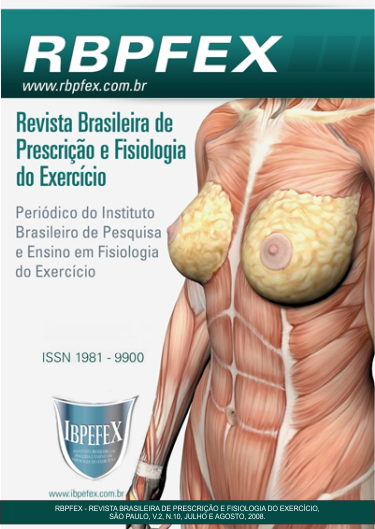The effect of a program of physical exercises in the weight training room for reduction of pain during the training and fight for Taekwondo: A case study of the knee injury.
Abstract
The objective of the case study is to strengthen the quadriceps an athlete of Taekwondo, with injury to cross later; to reduce the pain with a view to returning to training and fights (championships), Taekwondo. Materials and Methods: used is the method for organizing the training in cycles. In each cycle used is a method of strengthening muscle, always using the variability to give a new stimulus and continue the work. To evaluate the improvement of the pain and the inertia used is the "Questionnaire for Lysholm (SCALE)" and "Scale Associate," applied before the beginning of training and the end of each mesociclo. Results: were demonstrated in the form of tables for a better view of developments in the athlete during training. Discussion: The main objective of the training was reached, with some improvements in the quality of life (mainly in the leisure). The data and results were clear and sufficient, confirmed by the return of the athlete training and struggles (competitions), Taekwondo. Conclusion: for strengthening the quadriceps an athlete of Taekwondo, male; for the recovery of an injury to LCP; for improvement of the pain intended to return to training and competitions of Taekwondo, training in cycles (ranging methods for each mesociclo) the hall of bodybuilding was satisfactory, reaching the goals.
References
- Araújo, C.G.S. Correlação entre diferentes métodos lineares e adimensionais de avaliação da mobilidade articular. Revista Brasileira de Ciência e Movimento. Brasília. Vol. 8. Num. 2. 2000. p. 26.
- Araújo, C.G.S. Flexiteste: proposição de cinco índices de variabilidade da mobilidade articular. Revista Brasileira de Medicina do Esporte. Niterói. Vol. 8. Num. 1. 2002. p. 1.
- Bibliomed. Lesões de ligamentos. Retirado em 26/07/2007. 2005. p. 1-3.
- Brooks, D. Treinamento Personalizado: elaboração e montagem de programas. São Paulo. PHORTE. 2000. p. 233-268.
- Carrego, R.L.; Silva, L.C.C.B.; Gil Coury, H.J.C. Comparação entre dois testes clínicos para avaliar a flexibilidade dos músculos posteriores da coxa. Revista Brasileira de Fisioterapia. São Carlos. Vol. 11. Num. 2. 2007. p. 2.
- Carvalho, D.S.; Kowacs, P.A. Avaliação da intensidade de dor. Migrâneas Cefaléias. São Paulo. Vol. 9. Num. 4. 2006. p. 164-168.
- Clebis, N.K.; Natali, M.R.M. Lesões musculares provocadas por exercícios excêntricos. Revista Brasileira da Ciência e Movimento. Brasília. Vol. 2. Num. 4. 2001. p. 48.
- Cyrino, S.E.; Oliveira, A.R.; Leite, J.C.; Porto, D.B.; Dias, R.M.R.; Segantin, A.Q.; Mattanó, R.S.; Santos, V.A. Comportamento da flexibilidade após 10 semanas de treinamento com pesos. Revista Brasileira de Medicina do Esporte. Niterói. Vol. 10. Num. 4. 2004. p. 3.
- Honsi, D. Lesões ligamentares do joelho. Total Sport. Retirado em 24/07/2007. 2006. p. 1-2.
- Lippert, L.S. Cinesiologia Clínica para Fisioterapeutas. 3º Edição. Rio de Janeiro. Guanabara Koogam. 2003. p. 205-214.
- Lorete, R. Métodos e sistemas de treinamento de força. Rio de Janeiro. Retirado em 24/07/2007. 2006. p. 1-15.
- Peccin, M.S.; Ciconelli, R.; Cohen, M. Questionário específico para sintomas do joelho “Lysholm Knee Soring Scale” – tradução e validação para língua portuguesa. Acta Ortopédica Brasileira. São Paulo. Vol. 14. Num. 5. 2006. p. 1-12.
- Plapler, P.G. Reabilitação do joelho. Acta Ortopédica Brasileira. São Paulo. Vol. 3. Num. 4. 1995. p. 1-5.
- Putz, R.; Pabst, R. Sobotta: Atlas de Anatomia Humana. 20ª edição. Rio de janeiro. Guanabara Koogam. 1995. p. 284-293.
- Robergs, R.A.; Roberts, S.O. Princípios Fundamentais de Fisiologia do Exercício para Aptidão, Desempenho e Saúde. São Paulo. Phorte. 2002. p. 101-219.
- Vale, R.G.S.; Barreto, A.C.G.; Novaes, J.S.; Dantas, E.H.M. Efeitos do treinamento resistido na força máxima, na flexibilidade e na autonomia funcional de mulheres idosas. Revista Brasileira de Cineantropometria e Desempenho Humano. Rio de Janeiro. Vol. 8. Num. 4. 2006. p. 52-58.
- Vargas, A.; Almeida, A.; Lenz, C.; Macedo, M.; Ferreira, P. Joelho-Lesão Meniscal. Retirado em 24/07/2007. 2006. p. 1-7.
- Weineck, J. Biologia do esporte. São Paulo. Manole. 2000. p. 127-133.
Authors who publish in this journal agree to the following terms:
- Authors retain the copyright and grant the journal the right of first publication, with work simultaneously licensed under the Creative Commons Attribution License BY-NC which allows the sharing of the work with acknowledgment of the authorship of the work and initial publication in this journal.
- Authors are authorized to enter into additional contracts separately for non-exclusive distribution of the version of the work published in this journal (eg, publishing in institutional repository or book chapter), with acknowledgment of authorship and initial publication in this journal.
- Authors are allowed and encouraged to post and distribute their work online (eg, in institutional repositories or on their personal page) at any point before or during the editorial process, as this can bring about productive change as well as increase impact and impact. citation of published work (See The Effect of Free Access).






